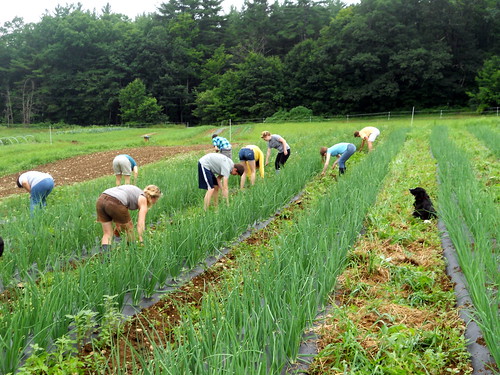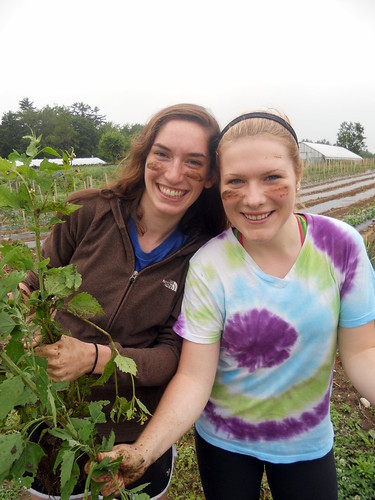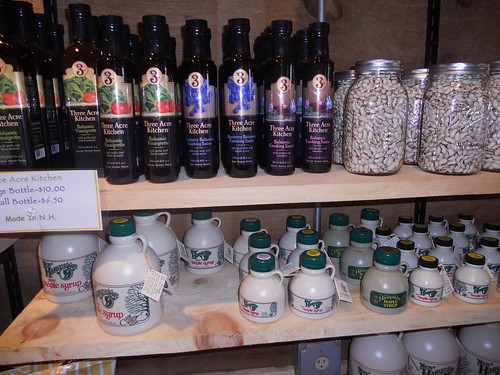In the span of just a few months in 2013, I discovered a new food and gained appreciation for a local food I’d been taking for granted.
This past summer, I spent five and a half weeks at the Advanced Study Program for high school juniors at Saint Paul’s School. There, I was immersed in a Sustenance and Sustainability course focused on what our food choices mean for the environment, other people around the world, our own health, and the animals that may be involved. My class members decided to participate in meatless Mondays. The dining hall at Saint Paul’s is very accommodating for all diets. Our decision arose after reading a book, Eating Animals by Jonathan Safran Foer, about how animals are treated and how greatly one’s carbon footprint increases with the addition of meat to one’s diet. Resources are used to care for and feed animals, while their manure releases large amounts of carbon into the atmosphere. I decided to eliminate meat from my diet completely while at Saint Paul’s, since the cafeteria provided plenty of options to do so. In the process, I learned about popular vegetarian foods, including quinoa. Quinoa is a grain with a high amount of protein, which factors into its popularity in the vegetarian diet. The grain, similar to rice or couscous, can be easily integrated into one’s diet, as I learned at Saint Paul’s. It can be eaten in soups, chilies, salads, pastas, for breakfast with maple syrup or brown sugar, or simply on its own as a side dish.
My personal favorite way to eat quinoa is simply as a salad mixed with various chopped veggies, feta cheese, and lemon juice squeezed on top for some extra flavor in place of salad dressing.


The Food and Agricultural Organization of the United Nations (FAO) officially declared the year of 2013 to be "The International Year of the Quinoa." Proposed by the government of Bolivia and receiving strong support from many Central and South American countries, quinoa has now been singled out by the FAO as a food with "high nutritive value," impressive biodiversity, and an important role to play in the achievement of food security worldwide (according to the world’s healthiest food website whfoods.com).
Along with its high nutritional value, most, if not all, quinoa you find will be organic, which is not only a plus to one’s health, but also for the environment, due to the absence of GMOs and chemicals that could be used to preserve the grain. Most quinoa eaten in the United States is imported from South America, but slowly this changing as the food becomes more popular as people learn how to grow, clean, prepare, and eat it.
Quinoa are the seeds of the goosefoot plant. Farmers in the Northwestern U.S. and Colorado are experimenting with growing quinoa. It does better in cooler, drier regions as rain during the autumn harvest time will cause the desirable seeds to sprout. I hope farmers will try to grow it in New Hampshire and then I’ll really be happy.
I found I loved my new diet, and I officially became a selective vegetarian. The choice of eating quinoa is one I can feel good about. Since it is good for my health and the environment; I never have to feel guilty about eating it. This is how I want to feel about all my dietary choices, including meat. It is important to me to know where my meat comes from and how my food is grown. I prefer my meat from free range, grass fed animals who have received no growth hormones.


So, in addition to learning to prefer vegetarian food, I also started choosing organic and locally grown food. In New Hampshire, we are known for our sugar farms where maple syrup is collected and processed. Living in rural New Hampshire, we are surrounded by many maple trees. Maple syrup is a popular condiment for our Sunday pancakes. There are many family-owned maple syrup farms, where if you stop in they will gladly show you around, talk about their operation, and sell you a little maple treat. Some even have their own breakfast restaurants and pancake parlors.

The process of making maple syrup is not a simple one. In the spring, maple trees are tapped through holes drilled into their trunks. Wooden or metal spouts are inserted in the holes and the sap drips into buckets or runs through tubing to central collecting places. Xylem sap is a root tissue in plants, such as bark, which is used to transport water and nutrients throughout plants. In cold climates, trees store starch in the xylem tissue. In the spring, the starch turns to sugar, and this is the sap that is collected for maple syrup. Once the sap is collected, it must be boiled to evaporate the water from the syrup. About 40 gallons of sap collected from the trees boils down to only one gallon of maple syrup.
Maple sugaring in my home state of New Hampshire has a long tradition, as it turns out the Native Americans collected and boiled off the water and showed the colonists how to do this. The Native people allowed the sugar to crystallize, as maple candy did not get moldy like the syrup. Now, people are worried that global warming will affect our maple trees, which are at the northern limit of their geographic range.
There are various grades of maple syrup, based on density. Each grade has a slightly different flavor. Grades include A and B, each with further grades of light, dark, or medium amber. Other maple products, such as maple candy, are made by heating the sap for longer. They taste sweeter because the sugar is more concentrated.
Fadden’s Maple Sugarhouse near my home just won its sixth award for “Best Maple Syrup in New Hampshire.” Judging is by a blind taste test administered by the New Hampshire Department of Agriculture and the New Hampshire Maple Producers Association. Fadden’s is open to the public and the syrup is for sale at Fadden’s General Store. They also ship it anywhere via U.S. Postal Service. Fadden’s claim is that the syrup is so pure because the operation is surrounded by thousands of acres of White Mountain National Forest.
Personally, I never eat a pancake or waffle breakfast without real maple syrup, and I often use it as sweetener for my tea or coffee. When I was living in Rome for a month with my Mom, we made frequent trips to the grocery store a few blocks away and there I saw some Maple Syrup from New England. I have never been more excited to see maple syrup.
Quinoa and maple syrup are two foods that serve as a main ingredient in my diet- a bit of compromise, as one is a local and one is a still, but hopefully not for long, “imported” food. From putting a little sweetener in my morning coffee to a vegetarian’s favorite side dish at dinner...to even combining the two into a yummy breakfast dish of quinoa topped with maple syrup.
Sydney Kahl is a member of the Youth Travel Blogging Mentorship Program
All photos courtesy and copyright Sydney Kahl
Quinoa and maple syrup are two foods that serve as a main ingredient in my diet - and here's why...
Posted by:
Sydney Kahl
